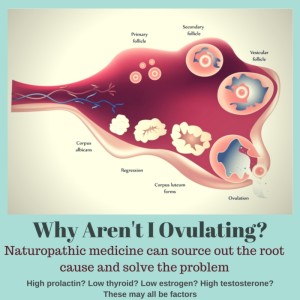
What is Ovulation?
By Dr. Pamela Frank, BSc(Hons), ND
Ovulation is the monthly release of an egg from one’s ovaries. The diagram above illustrates the process of ovulation.
What are the Symptoms of Ovulation?
You may or may not notice symptoms of ovulation. Common symptoms of ovulation include:
- Cervical mucous. Cervical mucous is a clear, slippery, stretchy mucous discharge that you may notice 1-3 days before you will ovulate. It’s a heads-up that ovulation is coming in 1-3 days, and when you see it, it is a good time to have intercourse if you are trying to conceive.
- Lower abdominal pain. You may notice a bit of pain or cramping on one side or the other of your lower abdomen. This pain may indicate that your ovaries are struggling to release an egg.
- Breast tenderness. Because ovulation is the point of the cycle when estrogen is at its peak, some women will notice PMS-type symptoms like breast tenderness.
- Mood changes. As with #3, the peak in estrogen can affect your mood.
- Change in your cervix. At ovulation, the tip of your cervix softens, feeling more like the firmness of your lips, whereas the rest of the cycle may feel more like the tip of your nose.
- Increased libido. Libido may increase around ovulation to prompt your body to get that egg fertilized.
What is Anovulation?
Anovulation means a lack of ovulation. It means your ovaries didn’t release an egg on a given cycle. Sometimes, there will be a lack of ovulation in every cycle, or you might skip some cycles of ovulation and ovulate in others.
What Causes Anovulation?
Anovulation can be caused by a number of hormone imbalances, although assumptions are often made that it has to do with hyperandrogenism. That is the case in PCOS, but not all anovulation is caused by excessive male hormones. Here are some common causes of anovulation:
Age
At perimenopause, your ovaries wind down, and egg production decreases in frequency, but it still occurs in some cycles. Once your period has been absent for a whole year and you are officially in menopause, ovulation usually stops. However, some women can still ovulate even after menopause. While I can’t reverse your age, I can help older ovaries work better through mitochondrial support. Once you are in full menopause, though, conception through natural methods is unlikely.
PCOS or polycystic ovarian syndrome
PCOS is one of the more common reasons for anovulatory cycles. In Classic PCOS, higher levels of androgens or male hormones interfere with the normal development and release of eggs. Restoring ovulation means correcting the high testosterone or DHEAs levels through lowering insulin. I can counsel on the proper diet for PCOS and how to restore regular ovulation through natural treatment.
Hypothyroid or Underactive thyroid
Think of your thyroid as the gas pedal for your body. An under-functioning thyroid means that the ovaries aren’t getting the proper stimulation to develop eggs. Low thyroid function can be helped with the proper nutrients (copper, zinc, selenium, tyrosine, and iodine) and, in the case of Hashimoto’s disease, moderating your immune system. I can help your thyroid work better.
High prolactin or hyperprolactinemia
High prolactin levels can inhibit ovulation. Prolactin increases during breastfeeding, which may hinder fertility while breastfeeding. Prolactin doesn’t always inhibit ovulation, so breastfeeding is not a reliable means of birth control. Blood levels of prolactin also go up due to stress. Stress reduction may help reduce prolactin levels and allow regular ovulation. Herbs and vitamin B6 can also help to lower excessive prolactin levels. Prolactin also has an inverse relationship with the neurotransmitter dopamine. Vitamins, minerals, and herbs can help with dopamine release, which can help moderate prolactin.
Low estrogen (estradiol)
Estrogen is necessary to mature follicles and produce healthy eggs. Low levels of estrogen mean eggs don’t fully mature enough to get released. My endocrine system support can help ovaries, adrenal glands, pituitary, and thyroid perform optimally for healthy estrogen production.
What are the symptoms of not ovulating?
How to know if you are not ovulating:
Irregular periods
The normal up-and-down cycling of estrogen and progesterone accompanying ovulation signals your body when it is time to get your period. If no egg is released, the appropriate signals aren’t being given to your body to menstruate.
Lack of a biphasic pattern on your basal body temperature charting
If you are not seeing a well-defined 2 weeks of lower temperatures, followed by 2 weeks of about 0.5 degrees Celsius higher temperatures on BBT charting, you may not be ovulating.
Excessive or prolonged menstrual bleeding
The production of progesterone after ovulation helps to prevent a thick uterine lining. A thicker lining is due to a lack of ovulation and, therefore, a lack of progesterone, which results in more bleeding during menstruation.
Severe menstrual cramps
If you don’t ovulate and don’t release progesterone, you can have worse period cramps. Progesterone acts as a muscle relaxant to prevent cramps.
Infertility
If you don’t ovulate, you obviously can’t conceive.
Can you have a regular period and not ovulate?
Yes, you can. A regular period is not a reliable indicator of ovulation.
Anovulation Research
Serum androstenedione, testosterone, thyroid-stimulating hormone, prolactin levels, and pelvic ultrasonography should be included in the initial investigations for anovulation. The 17-hydroxyprogesterone and dehydroepiandrosterone sulfate levels can be used for secondary anovulation evaluations. Chandeying P, Pantasri T. Prevalence of conditions causing chronic anovulation and the proposed algorithm for anovulation evaluation. J Obstet Gynaecol Res. 2015 Jul;41(7):1074-9. doi: 10.1111/jog.12685. Epub 2015 Mar 15.